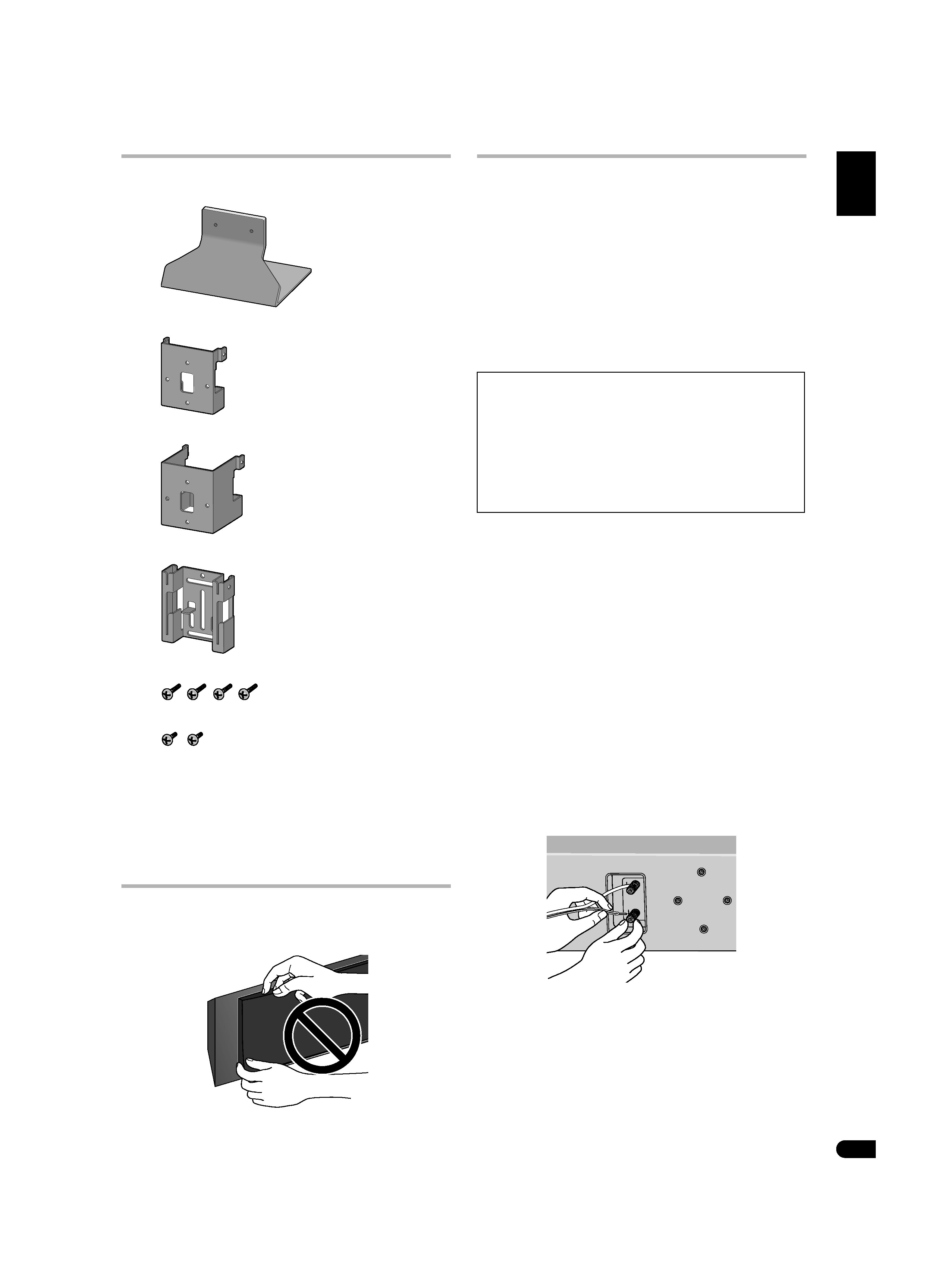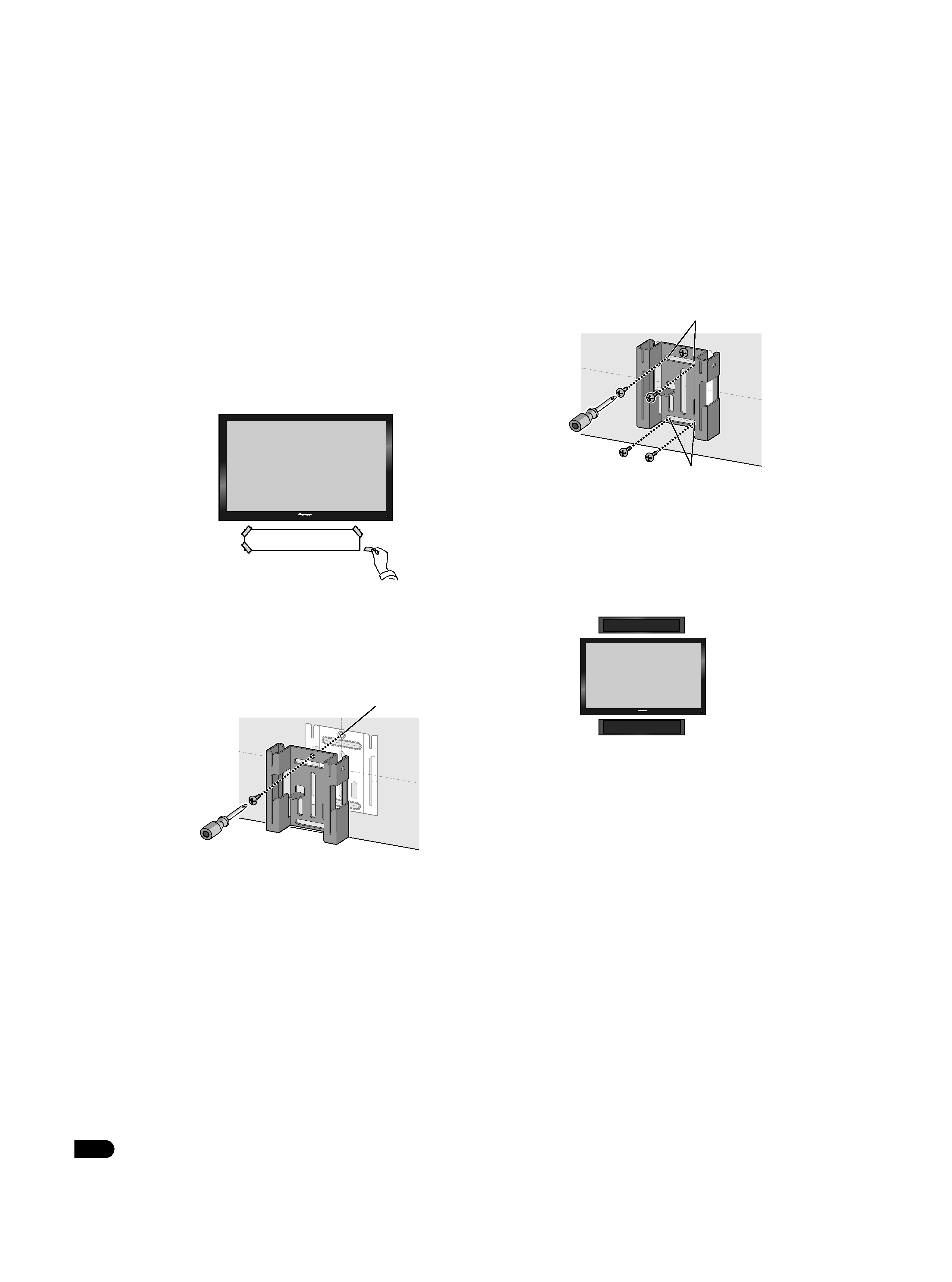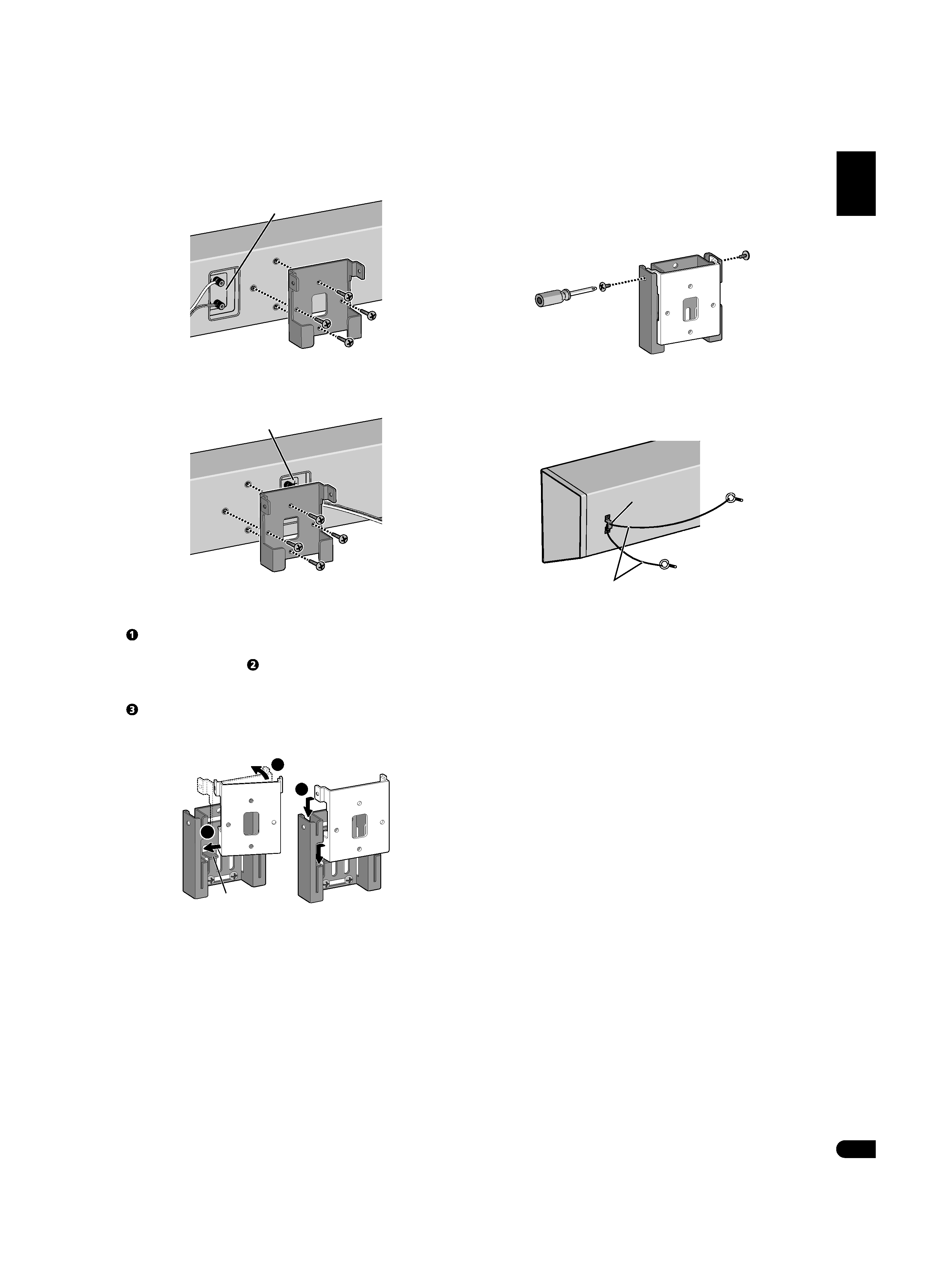
S-LX
C
Operating Instructions | Mode d'emploi |
Manual de instrucciones |
Speaker System
Enceinte acoustique
Sistema de parlante
S_LX70-C_En.book 1

2
En
Thank you for buying this Pioneer product. Please read through
these operating instructions so you will know how to operate your
model properly. After you have finished reading the instructions,
put them away in a safe place for future reference.
Before you start
· The nominal impedance of this speaker system is 6 . Connect
the speaker system to an amplifier with a load impedance of
6 (a model with "6 " displayed on the speaker output
terminals).
In order to prevent damage to the speaker system resulting from
input overload, please observe the following precautions:
· Do not supply power to the speaker system in excess of the
maximum permissible input.
· When using a graphic equalizer to emphasize loud sounds in
the high-frequency range, do not use excessive amplifier
volume.
· Do not try to force a low-powered amplifier to produce loud
volumes of sound (the amplifier's harmonic distortion will be
increased, and you may damage the speaker).
Care of the speaker cabinets
· With normal use, wiping with a soft cloth should be sufficient
to keep the cabinet clean. If necessary, clean with a cloth
dipped in a neutral cleanser diluted five or six times with water,
and wrung out well. Do not use furniture wax or cleansers.
Never use alcohol, thinners, benzine, insecticide sprays or
other chemicals on or near this unit since these will corrode the
surfaces. When using chemically-treated cloths, be sure to
carefully read their accompanying instruction manual.
Cleaning the glossy finish of the speaker system
· When cleaning the finish of the speaker system, gently wipe it
with a dry soft cloth; the supplied cleaning cloth.
· If you use a dusty or hard cloth or if you rub the screen hard, the
finish of the product will be scratched.
· If you clean the surface of the speaker system with a wet cloth,
water droplets on the surface may enter into the product,
resulting in malfunction.
Caution
Installation
· Do not place the speaker on an unstable surface, as doing so
may cause the speaker to fall and cause damage or bodily
injury.
· Switch off and unplug your AV equipment and consult the
instructions when connecting up components. Make sure you
use the correct connecting cables.
· When placing this unit, avoid areas where it may be likely to fall
and cause injury in the event of a natural disaster (such as an
earthquake). For more information, see page 5.
· Pioneer is not responsible for any accidents or damage that
result from improper installation, misuse or modification of the
product, or natural disasters.
Using the speakers
· Do not use the speaker to output distorted sound for long
periods of time. This can result in damages to the speaker and
poses a potential fire hazard.
· Do not sit or stand on the speaker, or let children play on the
speaker. Doing so could provoke the speaker to fall, causing
damages or bodily injury.
CAUTION
These speaker terminals carry
HAZARDOUS LIVE voltage. To
prevent the risk of electric shock when connecting or
disconnecting the speaker cables, disconnect the power cord
before touching any uninsulated parts.
S_LX70-C_En.book 2

E
ng
li
sh
F
ra
n
ç
a
is
E
sp
a
ñ
o
l
3
En
Confirm your accessories
· Speaker stand x 1
· Bracket (for speaker/S) x 1
· Bracket (for speaker/L) x 1
· Bracket (for wall) x 1
· Screw (long) x 4
· Screw (short) x 2
· Non-skid pad x 1 (set)
· Gasket (for speaker stand) x 1
· Self-adhering fastener (hook) x 2
· Self-adhering fastener (loop) x 2
· Cleaning cloth x 1
· Wall mounting template x 1
· Operating instructions
Speaker system grill
The speaker system grill cannot be removed. Do not try to forcibly
remove it since doing so may damage the grille.
Installing the speaker
This speaker system cannot be placed directly on the surface of
floors or shelves. Always attach to a wall using the supplied
brackets, or place on a flat and secure surface using the supplied
speaker stand.
· This speaker system is magnetically shielded. However,
depending on the installation location, color distortion may
occur if the speaker system is installed extremely close to the
screen of a television set. If this happens, turn the power switch
of the television set OFF, and turn it ON after 15 to 30 minutes.
If the problem persists, place the speaker system away from the
television set.
Mounting on walls
Once decided on the location of installation (such as the wall space
above or below of the TV), attach the speaker following the next
procedures.
Two types of brackets (for speaker) are supplied. When using
alongside with a Pioneer plasma television, use the L-type bracket.
When attaching flush against the wall, use the S-type bracket.
1
Connect speaker cable.
· Speaker cable is not included with this speaker system.
This speaker does not include speaker cables used for connecting
to an amplifier. Take the following factors into consideration when
choosing speaker cables so that you can get the most from your
speaker system:
· Use heavy-gauge speaker cable if possible, and keep the cables
to the minimum necessary length.
· Cables have differing characteristics. Keep this in mind when
using any cable.
· Connections at speaker and amplifier terminals should be
made as tight and secure as possible to help reduce contact
resistance.
When mounting the speaker onto wall using the bracket, connect
the speaker cable before attaching speaker onto the bracket.
· Make sure that the wall you intend to mount the speaker on is
strong enough to support it.
· Remember that the speaker system is heavy. Improper
installation of the speaker could cause it to fall and cause
damage or injuries to persons nearby.
· Mounting screws are not supplied. Use screws suitable for
the wall material and support the weight of the speaker.
If you are unsure of the qualities and strength of the walls,
consult a professional for advice.
S_LX70-C_En.book 3

4
En
· If the cables' wires happen to be pushed out of the terminals,
allowing the wires to come into contact with each other, it
places an excessive additional load on the amp. This may cause
the amp to stop functioning, and may even damage the amp.
· After connecting the plugs, pull lightly on the cables to make
sure that the ends of the cables are securely connected to the
terminals. Poor connections can create noise and interruptions
in the sound.
· Be sure to connect wires to the correct terminal polarities
(
+ , ) at the speaker and amplifier, or the proper surround
effect will not be produced.
2
Paste the supplied wall mounting template on the area of
installation.
Attach the template level to the ground using an adhesive such as
tape. Make sure the template is straight to avoid mounting the
speaker crookedly. Pasting the template too close to the TV may
cause the TV to get in the way of the speaker when installing. Make
sure the template and TV do not overlap.
3
Temporarily attach the bracket (for wall) to the specified
location on the template.
Align the bracket (for wall) to the specified location on the template,
and temporarily attach with a screw (6 mm diameter screw
recommended) at location [A].
Adjust the attachment position of the bracket so that it is aligned
with the template.
4
Attach the bracket (for wall).
Attach bracket with screws (6 mm diameter screws recommended)
at the 4 locations [B] (recommended). Firmly tighten the screw [A]
that was used to temporarily attach the bracket to the wall as well.
To avoid speaker from wobbling or falling off, firmly attach bracket
at multiple locations.
· Afterwards, remove the template by tearing along the
perforations.
· The following illustration is an example of attaching the bracket
with screws at five locations: Screw location [A] and the 4
corners of screw location [B] (recommended).
5
Attach the bracket (for speaker) onto speaker.
Attach the bracket on with supplied screws (long) at the 4 screw
holes.
This speaker system adopts a unique design that controls the
directionality of the sound. Due to this feature, this speaker system
must be mounted differently depending on whether it is being
installed above or below the TV. Attach the brackets in the direction
described below.
Template
[A]
[B]
[B]
Television
When installing above the TV
When installing below the TV
S_LX70-C_En.book 4

E
ng
li
sh
F
ra
n
ç
a
is
E
sp
a
ñ
o
l
5
En
·
When installing below the TV
Attach bracket so that the speaker terminal is on its left when
viewing the back of the speaker.
·
When installing above the TV
Attach bracket so that the speaker terminal is on its right when
viewing the back of the speaker.
6
Attach speaker onto bracket (for wall).
Place the bottom left edge of the bracket (attached on the speaker)
on top of the guide of the bracket (for wall) from a diagonal angle
().
Bring right side of both brackets together so that they become
horizontal to each other (
).
Move slightly to the left and slide down until stops, while aligning
the left protruding section to the groove of the bracket (for wall)
().
· The following illustration does not show the speaker attached to
the bracket (for speakers) for description purposes.
7
Secure brackets together with screws.
Secure the brackets together by using the supplied screws (short)
at the screw holes located on the top of the left and right side of the
brackets.
If you cannot secure both sides (due to such cases as lack of space
to use a screwdriver), make sure that one side is secured with a
screw.
8
Secure speaker to wall with a cord.
Screw two picture hooks or similar into the wall behind the speaker.
Pass a thick cord (not provided) around the hooks and through the
metal catch so that the speaker is stabilized (make sure to test that
it supports the weight of the speaker).
· Do not attach the metal catch directly to the wall. It should only
be used in conjunction with reinforced string to prevent the
speaker from falling.
Speaker terminal
Top
Bottom
Speaker terminal
Top
Bottom
Guide
1
2
3
Metal catch
Sufficiently thick
cord (not provided)
S_LX70-C_En.book 5
